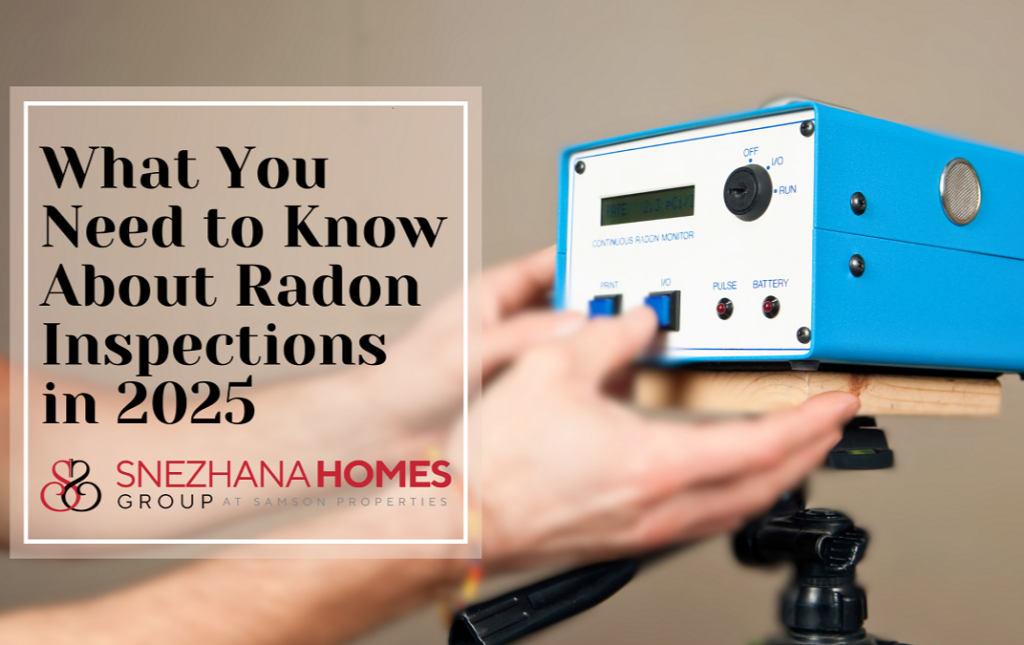What You Need to Know About Radon Inspections in 2025
By Snezhana Conway – Maryland & Washington DC Realtor | Snezhana Homes Group
When buying, selling, or renting a home in Maryland, Washington DC, or Northern Virginia, there’s one invisible factor you don’t want to overlook: radon.
💨 What Is Radon?
Radon is a naturally occurring radioactive gas that comes from the breakdown of uranium in soil, rock, and water. It’s completely odorless, tasteless, and colorless, meaning you can’t detect it without specialized testing. Yet its presence can have serious health consequences. According to the U.S. Environmental Protection Agency (EPA), long-term exposure to radon is the second leading cause of lung cancer in the U.S., behind smoking.
🧪 When Is Radon Testing Done?
In most DMV-area home sales, radon testing takes place during the inspection period. For rentals, it’s less common but increasingly requested by landlords and tenants seeking peace of mind. Tests are simple: a short-term electronic monitor or charcoal canister is placed in the lowest livable level of the home for 48–96 hours, providing reliable results.
📊 What’s Considered a Safe Radon Level?
As of 2025, EPA guidelines recommend:
Action is recommended at 4.0 pCi/L or higher
Levels below 4.0 pCi/L are considered acceptable
Many experts advocate mitigation above 2.0 pCi/L, particularly for sensitive individuals
💡 Tip from Snezhana Conway, your Maryland Realtor:
Radon testing is one of the simplest ways to ensure safety and peace of mind. In one of our Germantown rental homes, testing returned 2.0 pCi/L, well below the EPA action level—showing that even a brief test can confirm a property is safe.
Here are some practical do’s and don’ts:
✅ Do:
Test every home, regardless of location or age—radon levels can differ even between neighboring houses.
Place tests on the lowest livable floor for accurate readings.
Use a certified tester to ensure reliable results.
Review results carefully. Any level at or above 4.0 pCi/L warrants mitigation, and levels above 2.0 pCi/L may also be addressed for sensitive individuals.
Keep records—it’s reassuring for renters and can be a selling point for homeowners.
❌ Don’t:
Assume a home is safe without testing—it cannot be detected by sight, smell, or touch.
Ignore elevated readings—mitigation is affordable, effective, and typically costs $800–$1,500.
Delay testing until after moving in; early testing saves time, money, and stress.
🛠 What If Radon Levels Are Too High?
If levels exceed recommended thresholds, a licensed mitigation contractor can install a reduction system, typically including a fan and vent pipe to redirect radon outdoors. Buyers may request mitigation during inspection negotiations, and sellers often agree—it improves safety and future marketability.
📝 Is Radon Testing Required?
Maryland (Statewide): Not legally required for all sales but highly recommended, especially in areas with known elevated radon levels. Buyers often include radon inspection contingencies in contracts.
Montgomery County: Mandatory for single-family homes (detached or townhomes, not condos/co-ops) before sale, effective October 1, 2016. The seller must conduct the test or allow the buyer to do so, and results must be shared with both parties. Remediation is not legally required, and a high reading does not automatically cancel the sale.
Virginia & DC: No legal requirement, but many buyers request testing and sellers often comply.
Rentals: Some landlords test proactively, while others do so upon tenant request.
💛 SHG’s Take
At Snezhana Homes Group, we always recommend radon testing—for buyers, renters, or sellers. It’s quick, affordable, and gives peace of mind, protecting your long-term health.
Need a trusted radon inspector or want to review test results for a property? Let Snezhana Conway, your Maryland and DC Realtor, guide you every step of the way.
📩 Contact us today to schedule your consultation!
Source: U.S. Environmental Protection Agency (EPA) guidelines on radon exposure
